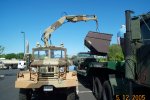FSBruva
New member
- 629
- 1
- 0
- Location
- Marietta, GA
So, in the PS magazine section, there is an issue about "why do the multi's smoke and spit oil out the exhaust?" and the answer came back to, "too much idling or low speed operations." A TB is mentioned, (which I can't find - TB 750-981-2), and the solution is to get the truck up to highway speed while loaded for 100 miles.
The topic then becomes - why is that the solution, and what causes the problem in the first place?
The end result (with respect to the exhaust) after a loaded highway trip, as we can all remember from Bjorn's travels, is that the EGT's will climb. So why would that help a oil slobbering deuce?
Anyways, just wanted to pick the collective brain of the think tank.
Matt
The topic then becomes - why is that the solution, and what causes the problem in the first place?
The end result (with respect to the exhaust) after a loaded highway trip, as we can all remember from Bjorn's travels, is that the EGT's will climb. So why would that help a oil slobbering deuce?
Anyways, just wanted to pick the collective brain of the think tank.
Matt




